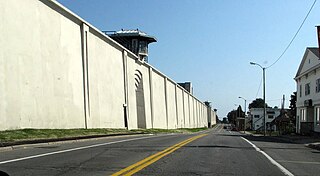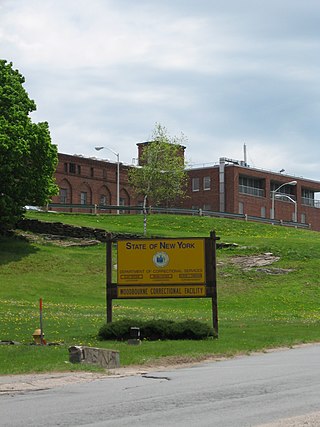Related Research Articles
Measure 11, also known as "One Strike You're Out", was a citizens' initiative passed in 1994 in the U.S. State of Oregon. This statutory enactment established mandatory minimum sentencing for several crimes. The measure was approved in the November 8, 1994 general election with 788,695 votes in favor, and 412,816 votes against.

George Lester Jackson was an American author, activist and prisoner. While serving an indeterminate sentence for the armed robbery of a gas station in 1961, Jackson became involved in revolutionary activity and co-founded the prison gang Black Guerrilla Family.

Attica Correctional Facility is a maximum security campus New York State prison in the Town of Attica, New York, operated by the New York State Department of Corrections and Community Supervision. It was constructed in the 1930s in response to earlier riots within the New York state prisons.

Sing Sing Correctional Facility, formerly Ossining Correctional Facility, is a maximum-security prison operated by the New York State Department of Corrections and Community Supervision in the village of Ossining, New York. It is about 30 miles (48 km) north of New York City on the east bank of the Hudson River. It holds about 1,700 inmates and housed the execution chamber for the State of New York until the abolition of capital punishment in New York in 2004.

The murder of Megan Nicole Kanka occurred in Hamilton Township, Mercer County, New Jersey, United States. Seven-year-old Megan Kanka was raped and murdered by her neighbor, Jesse Timmendequas, after he lured her into his house; Timmendequas had previously been convicted for child molestation. The murder attracted national attention and subsequently led to the introduction of "Megan's Law", which requires law enforcement to disclose details relating to the location of registered sex offenders.

California Men's Colony (CMC) is a male-only state prison located northwest of the city of San Luis Obispo, San Luis Obispo County, California, along the central California coast approximately halfway between Los Angeles and San Francisco.
Eric M. Smith is an American murderer who, at the age of thirteen, tortured and murdered a four-year-old child, Derrick Joseph Robie, in Steuben County, New York, on August 2, 1993. Smith was convicted of second-degree murder in 1994 and sentenced to the maximum term then available for juvenile murderers: nine years to life in prison. Smith was granted parole in October 2021, after 27 years in prison. He was officially released in February 2022.

Clinton Correctional Facility is a New York State Department of Corrections and Community Supervision maximum security state prison for men located in the Village of Dannemora, New York. The prison is sometimes colloquially referred to as Dannemora, although its name is derived from its location in Clinton County, New York. The southern perimeter wall of the prison borders New York State Route 374. Church of St. Dismas, the Good Thief, a church built by inmates, is located within the walls. The prison is sometimes referred to as New York's Little Siberia, due to the cold winters in Dannemora and the isolation of the upstate area. It is the largest maximum-security prison and the third-oldest prison in New York. The staff includes about 1000 officers and supervisors.
Five Points Correctional Facility (FPCF) is a maximum security state prison for men located in Romulus, New York, and operated by the New York State Department of Corrections and Community Supervision. Five Points is known as a supermax prison.

Woodbourne Correctional Facility is a medium security men's prison operated by the New York State Department of Corrections and Community Supervision in Woodbourne, New York of Sullivan County. It is located on the same tract of land as maximum security Sullivan Correctional Facility.
Prison Song is a 2001 American film directed by Darnell Martin. A prison film, its plot concerns a boy brought up in group homes who has a gift and passion for art. It also marked the film debut of future Oscar-nominated Mary J. Blige as an actress.
Elmira Correctional Facility, also known as "The Hill," is a maximum security state prison located in Chemung County, New York, in the City of Elmira. It is operated by the New York State Department of Corrections and Community Supervision. The supermax prison, Southport Correctional Facility, is located two miles away from Elmira.
Green Haven Correctional Facility is a maximum security prison in New York. The prison is located in the Town of Beekman in Dutchess County. The New York State Department of Corrections and Community Supervision lists the address as Route 216, Stormville, NY 12582. This prison housed New York's execution chamber during the time the state briefly had the death penalty in the post-Furman era. It was originally a federal prison and now houses maximum security inmates. Green Haven Correctional Facility also operated a Hot Kosher Foods Program; but no longer does as of 2020. However, because of this, the prison had a large Jewish population. Yale Law School operates the Green Haven Prison Project, a series of seminars among Yale law students and Green Haven inmates on law and policy issues concerning prisons and criminal law.
On January 27, 2001, Dartmouth College professors Half and Susanne Zantop, aged 62 and 55 respectively, were stabbed to death at their home in Etna, New Hampshire. Originally from Germany, the couple had been teaching at Dartmouth since the 1970s. High school classmates James J. Parker, age 16, and Robert W. Tulloch, age 17, were charged with first-degree murder.
The Richland High School shooting was a school shooting that occurred on Wednesday, November 15, 1995, in Lynnville, Tennessee, a small community located in Giles County. Seventeen-year-old James Ellison "Jamie" Rouse, a senior student at the school, killed one teacher and one student, and seriously wounded another teacher. This shooting is notable for having occurred prior to the Columbine shooting.
Rockville Correctional Facility is a state prison located in Adams Township, Parke County, one mile (1.6 km) northwest of Rockville, Indiana. A part of the Indiana Department of Corrections, it is the largest state prison for women in Indiana with approximately 1,200 women. Although it is classified as a medium-security prison, it has inmates of all security levels.

Craig Chandler Price is an American serial killer who committed his crimes in Warwick, Rhode Island between the ages of 13 and 15. He was arrested in 1989 for four murders committed in his neighborhood: a woman and her two daughters that year, and the murder of another woman two years earlier. He had an existing criminal record for petty theft.
The San Quentin Six were six inmates at San Quentin State Prison in the U.S. state of California who were charged with actions related to an August 21, 1971 escape attempt that resulted in six deaths and at least two persons seriously wounded. They were Fleeta Drumgo, David Johnson, Hugo Pinell, Johnny Larry Spain, Willie Tate, and Luis Talamantez. The dead included George Jackson, a co-founder of the Black Guerrilla Family; two other inmates, and three guards.

The history of violence against LGBT people in the United States is made up of assaults on gay men, lesbians, bisexuals, and transgender individuals (LGBT), legal responses to such violence, and hate crime statistics in the United States of America. Those targeted by such violence are believed to violate heteronormative rules and contravene perceived protocols of gender and sexual roles. People who are perceived to be LGBT may also be targeted. Violence can also occur between couples who are of the same sex, with statistics showing that violence among female same-sex couples is more common than among couples of the opposite sex, although male same-sex violence is less common.

Richard William Matt was an American murderer known for several prison escapes, most notably the 2015 Clinton Correctional Facility escape.
References
- 1 2 "84A6391". NYS Dept of Corrections and Supervision. Retrieved 22 December 2022.
- ↑ Bronx Leads City in Convictions Under Tough Juvenile Offender Act, The New York Times, March 24, 1981
- 1 2 3 "All God's Children: The Bosket Family and the American Tradition of Violence". C-SPAN. Retrieved February 23, 2019.
- ↑ Judge, Phoebe. "Willie Bosket". This is Criminal.
- 1 2 3 4 Fox Butterfield (2008). All God's Children: The Bosket Family and the American Tradition of Violence . Vintage Books. p. 142. ISBN 978-0-307-28033-6.
- 1 2 3 Paul Post (March 19, 2018). "Greenfield man, and former prison guard, recalls painful memory of nearly being killed by one of state's most violent felons". The Record.
- ↑ Dodge City, The Deadliest Precinct in Town, New York Magazine, August 28, 1978
- 1 2 Hager, Eli (2014-12-29). "The Willie Bosket Case". The Marshall Project. Retrieved 6 September 2018.
- ↑ Taylor-Greene, Helen (April 14, 2009). Encyclopedia of Race and Crime. SAGE Publications.
- ↑ Jailed 'Monster' Gets More Prison Time for Stabbing a Guard, The New York Times, April 20, 1989
- 1 2 John Eligon (September 23, 2008). "Two Decades in Solitary". The New York Times .
- ↑ Bosket profile at Crime Library